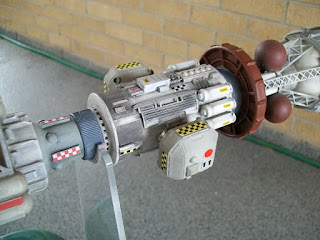The year is 2022. The 111 men and woman on board the ESE "Phoenix" embark on the greatest adventure mankind has ever known! But an encounter with a proton storm hurls the ship into the far reaches of the universe. Will the crew be able to survive the dangers of being lost in space...?
I came up with the second season premise primarily basing it on "Space: 1999"s year two. Love it or hate it, or you can meet in the middle. There is a lot of debate over the second season, too much for me to want to discuss at this time. I also decided to throw in elements from other sci-fi series, and their respective year two's (or three's even...). Into the Vitamix went bits from "Buck Rogers", "Lost in Space", and the Anderson feature film "Doppelganger" ("Journey to the Far Side of the Sun"). A pinch here and a dash there also from other obscure series, which will become more apparent as the story progresses.
Yes, this is blasphemy, and I know I will end up in Anderson Hell with the likes of The Hood, Captain Black, and Agent X20! But this is a spoof, and a love letter, so don't take it too seriously....
So obviously for the series we will need a ship. I had a vague concept in mind and over the period of many months, (even years thanks to some delays and diversions), and inspiration from Sir Martin Bower's work on 1999, (yes, I knighted him! It's not just about the actors...), created the ESE Phoenix.
Built by Johnson-Bower Aerospace in Lunar orbit for the European Space Exploration Center, the ship is 122 meters long (400 feet) and can fold space using a new propulsion system, but only in short bursts of 42 minutes maximum. More on the "science" later. Of course this being an Anderson production, we need an acronym:
P - Prototype
H - Hyperdrive
O - Outer
E - Exploration
N - Neutron
I - Injected
X - Experimental
This "studio scale" model, built at 1/96 scale, is the smaller of the two filming miniatures. It is used for long and medium shots. It is 51" long from command module to main motor, and is composed of seven distinct purpose-built sections.
Module A
Command and Control. All the piloting and ship operations are done from here. Personnel are pilot, co-pilot, science, navigation, communications, and weapons.
Module B
The Hub. Here are other operations of the ship including security, computer, and reception. This module also has two minor airlocks and the main airlock (with grappling arms). Opposite from the this is the large antenna array.
Module C
Primary life support. Everything to keep the ship's personnel alive and healthy. Atmosphere processors and scrubbers, water filtration, hydroponics, and recycling. Probably the most important section of the ship.
Module D
The Habitat Ring. It rotates at 1G (except during warp when it is locked down). Here are crew quarters, mess, medical bay, labs which require gravity, and common areas. There are also more external tanks for air and water, and since this is the section where most off duty personnel will be, 10 escape pods, which can hold 5 people each.
I decided to eliminate the idea of artificial gravity; it was too convenient. So I defaulted to spin gravity, the excuse being long term exposure to magnetic fields (gravity generators), causes brain damage. Of course this means there is no gravity in the rest of the ship. (Might make some of the scenes difficult to film, so we'll try to have people in chairs or standing holding handrails most of the time to keep the wire stunts to a minimum!)
Module E
This is the garage of the ship. It's for the two secondary spacecraft that dock here, and support such as maintenance & repair. An airlock on each side and magnetic grapplers to hold the ships. Eagles are being phased out in favour of these new prototype ships, called "Doves", which we will visit in a later post.
Module F
Main Engineering. Support for the ship in general, but mostly for monitoring the main motor and secondary drives. This module also has the two escape pods.
Module G
The final section is the main and secondary drives. The primary is a Mark VII Queller Drive. As mentioned it can fold space for short periods of time. But now it is much safer after all the issues with the Voyager probe ships. All the previous problems with the drive; the fast neutrons, the sound and pulsating distortions, have been rectified. But just to be safe there is a heavy shield between F and G.
The secondary drive are standard fusion drives, adapted and updated from the original Eagle design, but more powerful.
That's the basics of the Phoenix. I consider this a "bastard from outer space", the love child of the Leonev from "2010", and the Ultra Probe from the episode "Dragon's Domain". Here are some more images of the miniature.
Next post I'll break down the model to the individual modules and how I built this monstrosity. It's nice to build models like this, but the problem at the end of it all is where to put it!














